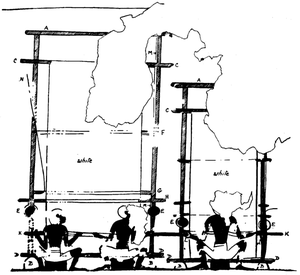The oldest surviving carpet is the Pazyryck carpet on show in Russia and dates back 2,500 years. But the workmanship and skill that was needed to make this piece indicates that the weaving industry is far older than we can prove at this point. Unfortunately carpets are made from wool which disintegrates over the centuries and thus there are not any other surviving pieces to testify to this statement. We can only go by legends and tales (most of which we now accept as myths) to give us some glimpse of the magnificence and importance of the weaving industry.
One early carpet, dating from the eighth century BCE, may still be seen in the British Museum - albeit carved in stone on an Assyrian relief - as a precious offering to a king. The stone floors of the seventh century BCE Assyrian palaces - especially at Nineveh and today also in the British Museum - are generally accepted as carpet patterns. Another legendary and magical flying carpet is that of King Solomon. Said to be given to him by God, it could carry 40,000 men at once and fly at the speed of light. The next great carpet we know of was found in the burial chamber of Cyrus the Great of Persia (559-529 BCE), when 200 years after his death, Alexander the Great crushed the remnants of Cyrus’ empire and, breaking into his tomb, described Cyrus’ golden funeral couch as resting on an exquisite golden carpet.
We know from a tablet of perhaps 3000 BCE that the Sumerians had looms. Ur was one of their great cities and the code of Hammarubi of around 1800 BCE records its major export being wool to Babylon. The tombs of Beni Hassan in Egypt (2800 BCE - 2600 BCE) have wall paintings of weavers at work, and there are numerous other Egyptian wall paintings from 2000 BCE that depict looms, showing already highly skilled weavers.
Biblical accounts tell the tale of Joseph and his multi-coloured coat as well as detailed instructions as to the materials and the manufacture of every part of the Tabernacle, including how the textiles were to be woven and how they were to be used to build the huge mobile tent to hold the Tablets of the Law during the Israelites wandering in the desert. This indicates that the skill of weaving and dying wool in different colours was already an established art form. Of course, the precursor to this would have been the development of material by means of weaving. It was a matter of time before the weaving of materials, tents, curtains, bedding and carpets would become a trade and commodity for the earlier weavers, especially through all the conquering and wars that was going on at the time.
So next time you look at your Persian carpet, even though it may be new, remember the weavers of thousands of years ago who perfected their craft and passed it on to the next generations in such a way that we can still enjoy the results of their craft and honing their skills. We always say: you can never really own a Persian carpet, you can only become the new treasurer of it until the next generation takes over.
Extracts: Jews And Carpets Fact Paper 18© Anton Felton and Samuel Kurinsky and Ancient Egyptian and Greek Looms BY H. LING ROTH (Keeper). WITH 38 LINE BLOCK AND ONE COLLOTYPE ILLUSTRATIONS. BANKFIELD MUSEUM, HALIFAX APRIL 1913



